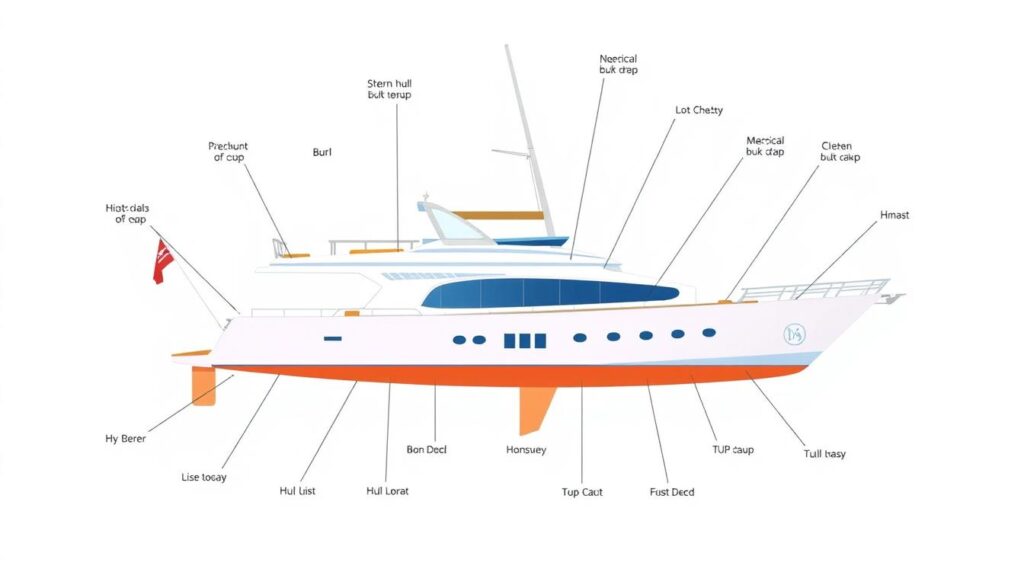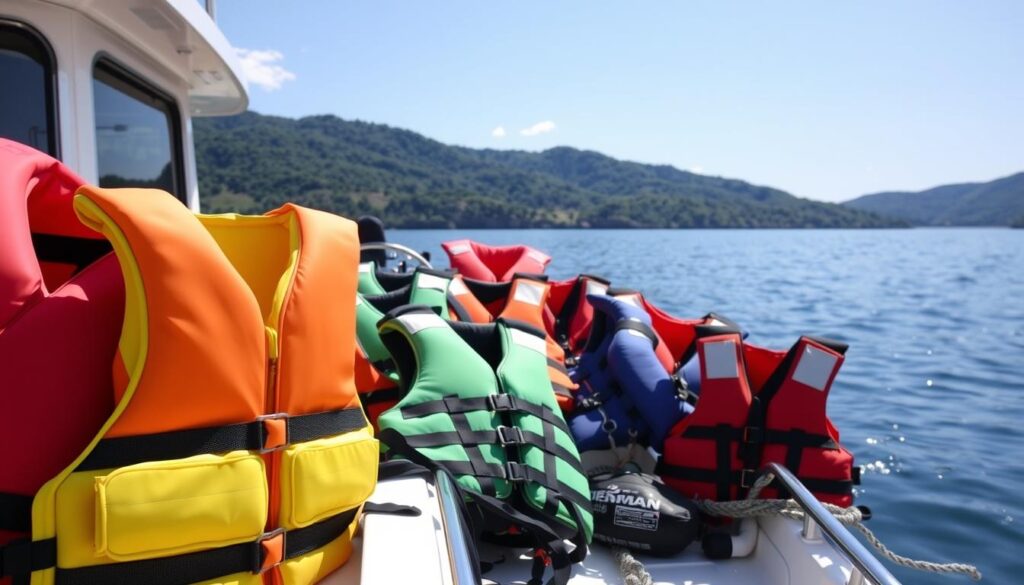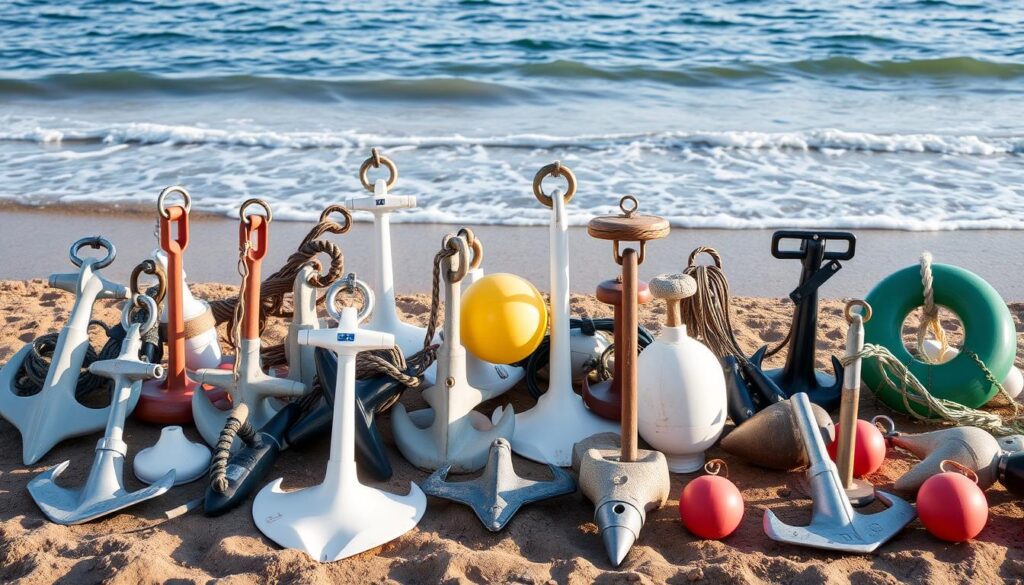Are you lost at sea with boating terms? Do you feel beaten with the aid of maritime vocabulary? Don’t fear, destiny captain! Learning key boat phrases is your guide to cruising comfortably and skillfully. But where did you start to learn this nautical language?
Starting your boating journey is exciting, but it can also be confusing. With so much new sailing jargon, it’s easy to get lost. But we’re here to guide you. We’ll help you analyze all of the critical nautical terms and become a pro at boat terms.
Table of Contents
Key Takeaways
- Learn essential boat terminology to communicate effectively on the water
- Understand directional terms like port, starboard, bow, and stern
- Familiarize yourself with parts of a boat and their functions
- Master navigational aids, charts, and plotting for safe boating
- Know crucial safety terms and emergency equipment on board
Basic Boat Terminology
To navigate like a pro, it is key to recognize primary boat phrases. Understanding boat elements and guidelines allows you to speak confidently with others. It also ensures that your time on the water is safe and amusing.
Parts of a Boat
Every boat has critical parts. The hull is the principal frame, keeping the ship afloat and constant. The bow is the front, and the stern is the lower back.
The beam is the most comprehensive element, typically at the center. The gunwale is the top edge of the sides. The transom is the stern segment in which the engine regularly sits.

The deck is the floor you stroll on. The keel runs from bow to stern along the hull’s backside. It keeps the boat stable and prevents it from slipping sideways.
Directional Terms
Knowing directional phrases is fundamental for secure and clean verbal exchange. Port is the left facet when dealing with forward, while starboard is the right facet.
Forward means toward the bow, and aft implies in the direction of the strict. Amidships manner the middle, each lengthwise and widthwise. This term facilitates locating matters on the boat, like “the existence jackets are saved amidships.”
| Term | Definition |
|---|---|
| Port | Left side of the boat when facing forward |
| Starboard | Right side of the boat when facing forward |
| Forward | Toward the bow (front) of the boat |
| Aft | Toward the stern (back) of the boat |
| Amidships | The central part of the boat, lengthwise and widthwise |
Learning those simple phrases enables you to navigate with confidence. It additionally makes talking with other boaters less complicated. Next, we will observe extra navigational terms to enhance your boating talents.
Navigational Terms
It is vital to realize crucial phrases to navigate the water properly. These encompass aids to navigation, nautical charts, tides, currents, and discovering your precise role. Learning these basics lets you propose trips, recognize your environment, and make clever picks simultaneously.
Aids to Navigation
Navigation aids are markers inside the water or on land. They display safe paths, dangers, and other vital info for sailors. [US Coast Guard, Aids to Navigation] You’ll locate buoys, beacons, lighthouses, and daymarks. Each has its own look and meaning, like shade and light patterns. Knowing those aids is vital for a secure journey.

Charts and Plotting
Nautical charts are unique maps of the ocean. They display depths, shorelines, and where to locate aids. It’s essential to discover ways to examine those charts. With gear like rulers and dividers, you could plan routes, degree distances, and find your spot using lifeless reckoning and triangulation. Find extra at NOAA Nautical Rules.
Tides and Currents
Tides and currents are massive in navigation. They alternate water ranges and the way vessels move. The moon and solar’s pull cause tides. Knowing tides is vital for a secure journey, especially in shallow waters. Currents move water sideways, affecting speed and route. Use tide tables and modern-day forecasts to plot your route and prepare for demanding situations.
“The prudent mariner will not rely solely on any single aid to navigation, particularly on floating aids.”
– United States Coast GuardLearning these phrases will prepare you to navigate accurately. Always use charts, aids, and electronic gear to locate your exact spot. This will keep you privy to your surroundings and facilitate your making clever picks on the water.
Boat Terms for Safety and Emergency
Boat protection is prime while you’re out on the water. Knowing critical safety terms and gear enables you to cope with emergencies properly. Recognizing the approximate existence of jackets and misery indicators is vital for a secure boating ride.
Personal Flotation Devices (PFDs)
Every passenger wishes for a Personal Flotation Device or PFD. Life jackets are the most unusual PFDs, keeping you afloat. Make sure the life jacket fits properly and comfortably. There are also throwables, like existing earrings or cushions, for a person within the water.

It’s additionally crucial to do muster drills or lifeboat drills. These drills educate everyone on how to get away and where to meet in an emergency. Practicing these drills guarantees everyone knows what to do in an emergency.
Distress Signals and Communication
Knowing how to signal for assistance in an emergency is key. Visual alerts like flares or orange distress flags alert others in your vicinity. Keep those signals easy to attain and recognize a way to use them.
Emergency conversation devices are also crucial. A VHF radio lets you communicate with other boats, the Coast Guard, and shore services. Learn to use it correctly and maintain it in good shape. An Emergency Position Indicating Radio Beacon, or EPIRB, sends your location to rescue teams in emergencies.
“Boating safety isn’t just about having the right equipment; it’s about knowing how to use it effectively in an emergency situation.”
– Captain John Smith, U.S. Coast GuardWhen the climate gets complex, steady free objects in your boat. If wanted, steer into the wind to keep control. Knowing these safety and emergency phrases makes your boating ride secure and a laugh.
Boat Equipment and Technology
Exploring the sea requires more than a sturdy boat. You want the right marine electronics and equipment. From anchoring to locating fish, the proper system makes a massive difference.
Anchors and Mooring
Anchoring keeps your boat in the vicinity while you’re not transferring. Many anchors, like Danforth and Plow, are used for one-of-a-kind sea bottoms. At night, an anchor light warns other boats that you are there.
Mooning means tying your boat to something like a buoy. You use strains and cleats for this.

- Anchor
- Anchor chain or rope
- Anchor winch or windlass
- Mooring strains
- Cleats
- Fenders
Sonar and Fishfinders
Sonar and fishfinders are key for anglers and boaters. They use sound waves to locate gadgets underwater, like fish. These tools display what is beneath a screen, helping you discover the correct fishing spots and stay safe.
There are many sonar sorts in present-day fishfinders:
| Sonar Type | Description |
|---|---|
| Traditional Sonar | Creates a cone-shaped beam with a single frequency, giving a basic underwater view. |
| CHIRP Sonar | Uses multiple frequencies for a detailed image, better target separation, and deeper penetration. |
| Side Imaging Sonar | Scans the water on both sides with a thin beam, showing structure and fish in detail. |
| Down Imaging Sonar | Focuses the beam below the boat for a detailed view of the bottom and fish. |
“A fishfinder is like a window into the underwater world. It allows you to see what’s beneath the surface, so you can make informed decisions about where to fish and how to navigate.”
– Bill Dance, Professional AnglerOther essential boat gadgets include bilge pumps and marine radios. These help keep the boat dry and allow you to communicate with other ships and shore. You are ready for a secure and fun time on the water with the right tools.
Sailing and Maneuvering Terms
Learning sailing phrases is prime for shifting your boat smoothly and talking with your group. You’ll hear approximately tacking, gybing, and healing, explaining how the boat acts and its role to the wind. Knowing these terms allows you to sail with a bit of luck and safely.
Understanding the factors of sail is critical. Sail indicates the boat’s route to the wind. The close-hauled method involves sailing as close to the wind as feasible. Beating involves sailing in zigzags in the direction of the wind. Reaching is between close-hauled and running, with the wind coming from the side.
Tacking and gybing are key for converting paths. The tracking method turns the bow via the wind to interchange facets. Gybing is turning the stern through the wind to interchange aspects again. Doing those smoothly maintains management and avoids accidents.
“The pessimist complains about the wind; the optimist expects it to change; the realist adjusts the sails.”
– William Arthur WardHealing happens when the wind leans the boat to one side. Skilled sailors regulate the sails and weight to balance the boat. Luffing occurs when the sail’s aspect flutters in the wind. Turning the boat into the wind makes the sails luff and slows the ship down.
| Term | Definition |
|---|---|
| Aback | Describes a sail when the wind strikes it on its lee side. |
| Running | Sailing with the wind blowing exactly aft, in line with the boat’s centerline. |
By gaining knowledge of those terms and practicing, you may sail like a seasoned pro. Always keep protection first while sailing. Learning proper techniques and communication makes your cruising revel in safety and a laugh.
Weather and Sea Conditions
Knowing about marine climate and sea conditions is fundamental for secure boating. Sailors and boaters want to recognize wind route, pace, sea kingdom, waves and swells. This knowledge facilitates them in making clever selections at the same time as at the water.
Wind Direction and Speed
Wind course and velocity significantly affect waves and swells. Sailors sense a mix of the proper wind and the wind from the boat’s movement. Weather maps display wind patterns by using connecting points of equal stress.
Here are a few commonplace wind course phrases:
- Abeam: At right angles to the boat’s centerline
- Lee facet: The facet of the ship sheltered from the wind
- Leeward: Away from the wind, the direction in which the wind blows
- Windward: The route the wind is blowing from
Wave and Swell Terminology
Waves and swells are crucial to understanding sea conditions. Swells are waves that have traveled far from where they began, displaying a standard sample. A wave’s top is the space from the top to the bottom of a wave.
Here are some essential wave and swell terms:
| Term | Definition |
|---|---|
| Swell height | The vertical distance between the crest and trough of a swell. |
| Swell period | The time interval between two consecutive swell crests. |
| Swell direction | The direction from which the swell is coming. |
| Wave steepness | The ratio of wave height to wavelength. |
| Breaking waves | Waves that collapse and break due to excessive steepness or interaction with the seabed. |
“The sea, once it casts its spell, holds one in its net of wonder forever.”
– Jacques Yves CousteauBy keeping up with the marine climate, wind, sea nation, waves, and swells, boaters can live securely and have fun on the water.
Conclusion
Learning crucial boat terms is fundamental to being a safe and confident boater. Knowing the basics of boat elements, navigation, protection gear, and weather helps you cope with any water situation. This information improves your conversation with others and enables you to make intelligent protection and navigation selections.
Those terms become easy for you as you research more significant and beneficial experiences. You’ll apprehend nautical charts, climate reviews, and how to talk to the Coast Guard or other boaters in emergencies. Learning those phrases is funding for your protection and amusing on the water.
Whether you’re an experienced sailor or new to boating, hold studying and enhancing. Stay present-day with boating tech, take protection publications, and exercise your navigation capabilities. This way, you may be extra assured and professional, helping keep the boating community safe. So, set sail with self-assurance, understand your critical boat phrases, and revel in the journey of exploring the open waters.
FAQ
What are the basic parts of a boat?
A boat has several key parts. These include the bow (front) and stern (back). The hull is the main body, and the deck is the top. The gunwale is the side edge, and the transom is the back edge.
Port means left, and starboard means right. These terms help you navigate.
What does “amidships” mean?
Amidships is the middle of the boat. It’s both side to side and front to back.
What are aids to navigation?
Aids to navigation help show safe or unsafe waters. They include buoys, beacons, and lights.
What is a nautical chart?
A nautical chart is a map for sailors. It shows water and shoreline features. This includes depths, aids to navigation, and obstructions.
What is a personal flotation device (PFD)?
A PFD, or life jacket, keeps you afloat. It’s a buoyancy aid for water safety.
What is a VHF radio used for on a boat?
A VHF radio helps with communication. It’s used for talking between boats, marinas, and the Coast Guard. You can also get weather updates and distress calls.
What is the difference between a sonar and a fishfinder?
Sonar uses radio signals to find underwater objects. A fishfinder is a type of sonar. It finds fish and shows water depth.
What does it mean to tack or gybe when sailing?
Tacking means turning through the wind to change direction. Gybing is turning the stern through the wind to change tack.
What is the difference between true wind and apparent wind?
True wind is the actual wind speed and direction. Apparent wind is what a moving boat feels. It’s the true wind plus the wind from the boat’s motion.
What is the importance of learning boat terms for boaters?
Knowing boat terms is key for communication and safety. It makes boating more enjoyable. Understanding nautical phrases and vocabulary helps you navigate confidently.

